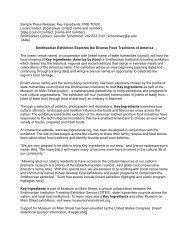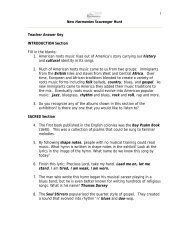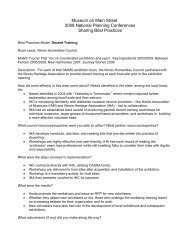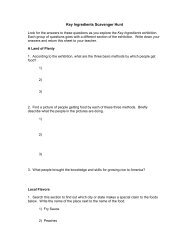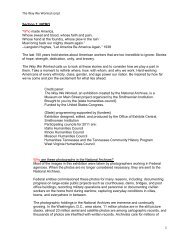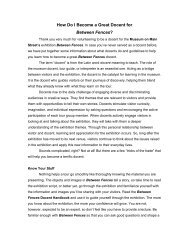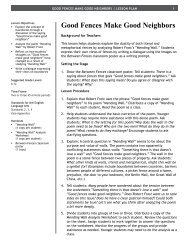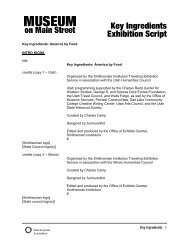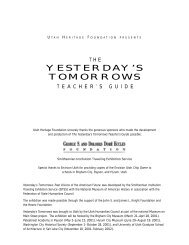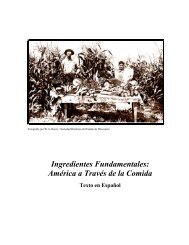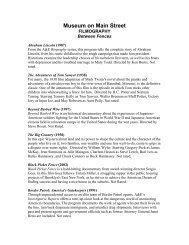Exhibition Docent Handbook - Museum on Main Street
Exhibition Docent Handbook - Museum on Main Street
Exhibition Docent Handbook - Museum on Main Street
- No tags were found...
Create successful ePaper yourself
Turn your PDF publications into a flip-book with our unique Google optimized e-Paper software.
THINK ABOUT ITEncourage your visitors to compare John White’s1585-86 watercolor of the Indian village Secot<strong>on</strong>and the painting of Jamestown, Virginia, as it mayhave appeared in 1614. Ask them to c<strong>on</strong>sider theuses of the fences in each image and the impactof col<strong>on</strong>izati<strong>on</strong> <strong>on</strong> the landscape.LET’S TALK• John Winthrop wrote in 1629 that Native Americans“ruleth over many lands without title or property . . .they inclose no ground.” How do you think col<strong>on</strong>istsviewed this approach to the land? How do you thinkthis difference may have affected relati<strong>on</strong>shipsbetween the two groups?• Take a look at the tall stakes or pales <strong>on</strong> theexhibiti<strong>on</strong> panel and imagine an entire fence builtfrom such stakes. How would you resp<strong>on</strong>d to this typeof fence? Can you find a similar fence type in theimages here? Why do you think the triangular palisade(fence of pales) at Jamestown was built?• The suburban picket fence may have had its originsin this type of defensive palisade. Do you thinkthat palisades and picket fences have the samefuncti<strong>on</strong>? Today, what kinds of fences serve the samefuncti<strong>on</strong> as palisades?• What do you think the 1734 and 1793 imagesof America’s col<strong>on</strong>ial landscape tell you about theimpact of fences <strong>on</strong> the new country? (Hints: typesof fences, deforestati<strong>on</strong>, definiti<strong>on</strong> of property,city planning, relati<strong>on</strong>ship between cultures.)• Rectangular land surveys, like the <strong>on</strong>e in Wisc<strong>on</strong>sin,have been called a “vicious mode” of dividing landand a way to achieve “neatness, order, and stability.”(Quotes are located behind the slider of Iowa farms.)Why do you think the surveys were c<strong>on</strong>sidered“vicious”? Do you think order and neatness arebeneficial to communities? Why or why not? Do youthink that rectangular land surveys encouragedisolati<strong>on</strong> or prevented c<strong>on</strong>flict am<strong>on</strong>g neighbors?



